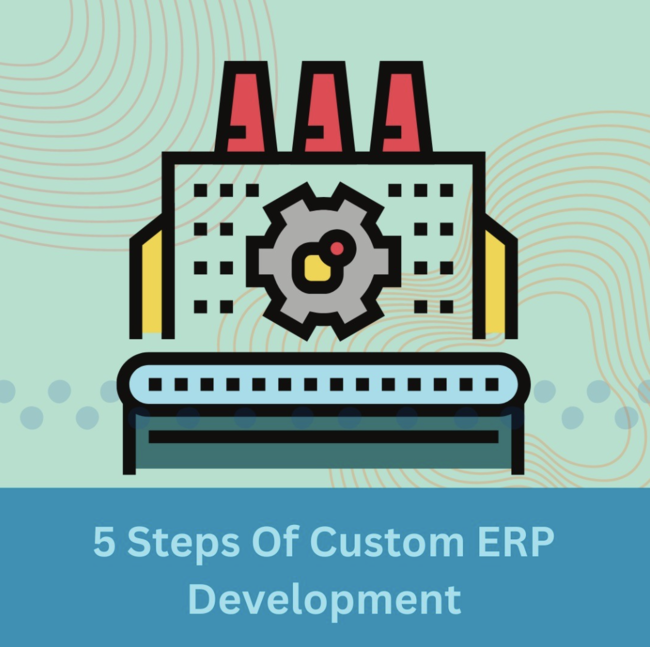5 Steps Of Custom ERP Development

Enterprise Resource Planning (ERP) is a core part of managing any business. It streamlines processes such as inventory, accounting and operations. Custom ERP software helps businesses tailor their software to their exact needs, giving them more control over the system that runs their business. But the process can be complex, so it’s important to understand the steps involved in custom ERP development before starting. In this blog post, we will outline five key steps of custom ERP development.
What Are the Steps of Custom ERP Development?
1. Setting The Goals/Expectations
The first step in any custom ERP development project is to sit down with key stakeholders and define the goals and expectations for the project. This step is critical to the success of the project, as it will set the tone for the entire development process.
During this step, it is important to be as clear and concise as possible when defining the goals of the project. All stakeholders should have a good understanding of what is expected from the final product. Once the goals are defined, they should be communicated to all members of the development team so that everyone is on the same page.
After the goals are set, it is time to start planning out the development process. This step will involve creating a detailed roadmap that outlines all of the milestones that need to be met during the course of the project. The roadmap should be reviewed and approved by all stakeholders before work begins.
2. Designing The UI/UX
Designing the UI/UX of a custom ERP system is a critical step in the development process as it defines the experience end users will have with the system. A good UI/UX will make the software easy to use and navigate, while a bad UI/UX can make even the most user-friendly system difficult to use.
There are a few key things to keep in mind when designing the UI/UX of a custom ERP system:
- Keep it simple: The simpler the design, the easier it will be for users to understand and use the system.
- Make it intuitive: Intuitive design means that users will be able to figure out how to use the system without needing any training.
- Use familiar conventions: Familiar conventions make it easier for users to understand how to use the system. For example, using icons that represent common actions (such as a trash can icon for deleting an item) can help users understand what they need to do.
3. Deciding The Tech Stack
Deciding on the tech stack is a comprehensive process. From finalizing software to be used in the front and back end to system hosting and more, a lot of planning is required to navigate this stage. Here are a couple of key aspects of the tech stack:
System Hosting
It’s vital to determine where the system will be hosted. If the system is hosted on an internal server, then it should be powerful enough to handle the load. Updates and security patches will have to be managed internally.
Cloud-based providers take care of all of this, but their security measures need to be up to par. The cost of subscription fees when budgeting for the custom ERP development project will also have to be factored in.
Database
An ERP development process begins with the database. This is where all of the data for the company will be stored. The database can be either on-premises or in the cloud. Once the database is set up, the next step is to create the tables and fields that will be used to store data.
4. Integration With Third-Party Products
Most enterprise resource planning (ERP) solutions offer some level of integration with third-party products. This allows organizations to connect their ERP system with other software solutions they use, such as accounting, customer relationship management (CRM), and supply chain management (SCM) systems.
Integration can make it easier for businesses to track data and information across all of their different software solutions. It can also help to automate processes and tasks that span multiple systems. For example, if a customer places an order in a CRM system, the order can be automatically sent to the ERP system for fulfillment.
When evaluating ERP solutions, it is important to consider the level of integration offered. Some ERP systems are designed to work with specific third-party products, while others offer more general integration capabilities. It is also important to consider the costs associated with integration, as well as the time and effort required to set it up.
5. Testing And Recalibrating The ERP Software
Before starting the final stages of custom ERP development, it's important to test and recalibrate the software to ensure everything is working as intended. This process can be done by setting up a test environment that mimics the live system as closely as possible. Once the software is running in the test environment, various types of tests can be performed to check for errors and correct any that are found. Recalibration may also be necessary if changes have been made to the system during development.
The Takeaways
There are many benefits to custom ERP software, but there are also a few potential risks. Here are the key takeaways from this article:
- Have a clear understanding of the business needs before starting any ERP development project.
- Work with an experienced ERP development partner who can help navigate the process and ensure a successful outcome.
- Be well-versed in all stages of the process right from planning to UI/UX design and implementation.
